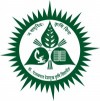| Historical Perspective of the Centre | ||
| Faculty Information | ||
| Agroclimatic Information | ||
| Mandate | ||
| Major Research Achievements | ||
| Contact Information |
Historical Perspective of the Centre
Rainfed areas in the country India occupy about sixty seven percent of arable lands and contribute to the production of a major proportion of nutritive cereals, pulses, oilseeds and cotton to the national grainary. These regions, unfortunately suffer from poor productivity because of degraded lands, poor water holding capacity and multiple nutrient deficiency, erratic rainfall, small land holdings and the like.
In order to deal with these problems appropriately, Indian council of Agricultural Research (ICAR) started All India Coordinated Research Project for Dryland Agriculture (AICRPDA) in 1970 with the assistance from the Government of Canada. The unique feature of this project was its reliance on multidisciplinary research approach in identifying constraints and providing viable solutions to location specific problems in all the agro-ecological situations of rainfed agriculture. The project presently has 25 co-operative centres. The locations of the various centres are depicted in Fig. 1. The establishment of Central Research Institute for dryland Agriculture (CRIDA) at Hyderabad in 1985 gave an impetus by providing basic and strategic research support. Some centres were supported with AICRP on Agro-meteorology in 1995. Akola centre is one of them. The profile briefs the outcome of various research activities during the past 10 years.
Agro Climatic Information
Region

Network for Dryland Research Centre
Vidarbha region of Maharashtra state is mostly characterized by dryland farming. The climatic conditions of this region can be broadly described as semi-arid. The jurisdiction of Dr. Panjabrao Deshmukh Krishi Vidyapeeth is entire Vidarbha region. It is richly endowed with natural resources of varied types. Akola centre strives to solve location specific complexities through a cohesive, multi-pronged approach, emphasizing farmers’ point of view all the time.
The region comprises eleven districts viz. Buldana, Akola, Washim, Amravati, Yavatmal, Wardha, Nagpur, Bhandara, Gondia, Chandrapur and Gadchiroli. It lies in between 170 57’ – 210 46’ N Latitude and 750 57’ – 800 59’ E Longitude. It covers an area of 97762.9km2, which is 31.92 percent area of Maharashtra. Satpuda hill ranges in North bound the region, Ajanta hill ranges at the South West and a series of high hill ranges along the eastern border. It is divided into Godavari and Tapi river basins. There are two revenue administrative divisions viz., Amravati and Nagpur.
Weather and season of the region
The mean annual rainfall ranges from 700 mm at the West to 1700 mm at the East. The day length and temperature varies giving a rise from North to South and rainfall from West to East. Thus it gives rise to various agro climatic situations. This region mostly receives adequate rainfall in aggregate in monsoon period but suffers from vagaries of distribution and consequently the scarcity and semi-scarcity conditions. Some pockets in Khamgaon tahsil of Buldana district are drought prone.
Monsoon sets in from 8th June regularly and rains commence in between 18th to 25th June gives highest rainfall during July and August and withdraw on 8th October. However, rains are meagre after first fortnight of September, Total rainy days ranges in between 47 to 65. The coefficient of variation of monthly rainfall is 40 to 50 per cent even for the wet month i.e. July indicating the uncertainty of rains during the season.
The climatic conditions of the region can be broadly described as semi-arid type on annual basis. The region experiences sub-humid to humid conditions in monsoon season, semi-arid in winter season and arid in summer season. Vidarbha region has been divided into three agro-climatic zones based on rainfall, soil types and vegetation viz., Western Vidarbha Zone (Rainfall 700 to 950mm), Central Vidarbha Zone (Rainfall 950 to 1250mm) and Eastern Vidarbha Zone (Rainfall <1250mm).
Agro-ecological characterization of the location
Akola is situated at the latitude of 200.42’ North and Longitude of 770.02’ East. The altitude of this place is 307.41m above MSL. The climate of the place is sub-tropical and characterised by hot dry summer and cool winter. Rains are mostly received from South-West monsoon during June to October with mean annual precipitation of 824.8mm, which is generally received in 41 rainy days. Winter rains are uncertain but has an average of 86.9mm during October to January. The annual mean minimum temperature varies from 10.5 to 27.10C, while the mean maximum temperature ranges from 28.2 to 42.60C. The bright Sunshine hours ranges between 4.1 – 10.0/day and wind speed from 4.3to14.8km/hr. The morning relative humidity ranges between 35 to 87 and evening humidity between 14 to 68 per cent.
Soils
Western Vidarbha soils are derived from trap rock and have varying depth depending upon their physiography. Most of the soils are calcareous, highly base saturated, fairly well drained, well supplied with potash, moderate to low in phosphate, but low in organic matter content and slightly alkaline. Soils deeper than 1.5 m and clay in texture pose problem of waterlogging. Such conditions occur in Purna Valley. Deep soils are poor in infiltration and permeability. At Dryland Research Farm of the centre, the soil belongs to Vertic Inceptisols.
Soils of the Central Vidarbha are derived from basalt rock, black in colour and having varying depth depending upon their physiography. Inceptisols and Entisols are developed from basalt and they are very shallow to shallow. Inceptisols show vertic characteristics, whereas, the Vertisols are developed in basaltic alluvium brought out by rivers. These soils are medium to heavy in texture, high in lime content with high base saturation.
Vertisols are predominant in the zone with montmorillonite/smectite clay. Swelling after wetting and shrinkage following drying results in deep and wide cracks.
Eastern Vidarbha soils are chiefly derived from mixed rocks like granite, geniuses and schist’s. They are yellowish brown to red in colour and having pH in the range of 6 to 7. These soils predominantly contain Kaolinite (1:1), non-expanding clay mineral.
Medium deep black soils are predominant (45%) followed by coarse shallow (35%) and deep black soils (20%).
Major problems of the region
Vidarbha is mainly a rainfed-farming region, the crops being dependent on vagaries of monsoon. This makes living of the farmers unstable and difficult, because of uncertainty in yield and income. Due to lack of agrobased and cottage industries, employment and monetary returns are meagre. Important problems of the region are
a. Fragile environment
Total annual mean precipitation of the region is, though, above 700mm, its distribution is not even. Due to erratic and irregular rainfall pattern, crops suffer and there is also a risk of crop failure under aberrant weather situation. Due to frequent occurrence of dry spell, delayed onset of monsoon and early withdrawal, prospects of good crop cannot be assured. Sometimes excessive and intensive rainfall may cause runoff and severe erosion.
b. Soil degradation
Soils of the region have been degraded due their susceptibility to soil and water erosion, inadequate restoration of soil organic matter due to tropical climate and lack of supply of organic manures and thirdly due to improper use of land. In some pockets, there is excessive accumulation of salts making soils saline and alkaline.
c. Constraint of water
Due to lack of appropriate rainwater management, availability of water for crops is declining. Similarly level of groundwater is also going downward because of excessive lifting of water and lack of efforts to replenish removed water. This is a matter of great concern and poses serious challenge for the future.
d. Low productivity
Crop and animal productivity is very low in the region because of low inputs and non-adoption of improved technology, viz., low income and low livelihood security, inadequate finance for agriculture, lack of supporting enterprises in rural area, lack of post harvest cottage and agro based industries, unavailability of labour and farm equipments for timely field operations and unavailability of good quality seed, timely availability of desirable fertilizers and pesticides etc.
Mandate
- To evolve simple technologies through inter disciplinary research to substantially increase the crop productivity and viability under dryland farming conditions in India
- To increase stability of crop production over the years by improving in natural resource management and crop management systems and providing alternate crop production technologies matching weather conditions
- To develop alternate and efficient land use systems through inter disciplinary research and farmers’ perspective and operational scale experimentation
- To optimise the use of natural resources viz., rainfall, land and water; minimize soil and water losses and degradation of environment
- To evaluate and study transferability of the improved dryland technologies on farmers’ fields.
Major Research Achievements
- · In rainfed condition for sorghum crop, minimum tillage (one hoeing followed by one hand weeding) with 20kg nitrogen through inorganic fertilizer+ 20kg N through FYM (3.8t ha-1), 40kg P2O5 and 40kg K2O as basal dose and remaining 20kg nitrogen through inorganic fertilizer + 20kg through glyricidia (3t ha-1, at 30 DAS) is recommended for higher rainwater use efficiency, higher grain yield and enhanced soil fertility.
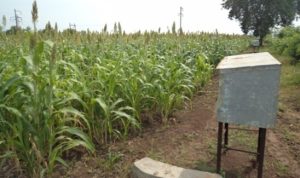 |
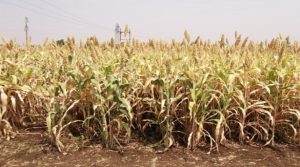 |
- For obtaining higher system productivity and system profitability, sowing non Bt. cotton + soybean (4:10) – safflower cropping sequence with tractor drawn seed drill and application of 45:55:30 kg ha-1 NPK to the cotton + soybean (4:10) intercropping and 13.75:13.75:13.75 kg ha-1 NPK to safflower is recommended for dryland condition of vidarbha region.
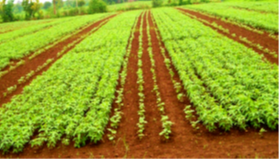 |
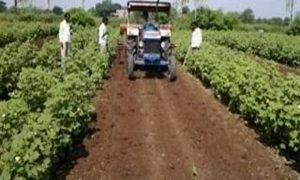 |
- Under dryland condition, for higher productivity and monetary returns, intercropping of vegetables in hirsutum cotton (Cotton + cowpea or clusterbean) sown at 45 cm in 1:1 row proportion and application of 125% RDF (75:37.5:37.5 NPK kg ha-1) in two split doses i.e. half dose of N, full dose of P and K applied at the time of sowing to cotton + vegetable intercrops (37.5:37.5:37.5 NPK kg ha-1) and remaining half dose of nitrogen (37.5 kg ha-1) applied at 30 DAS to cotton crop is recommended.
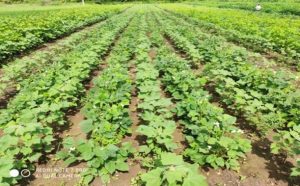 |
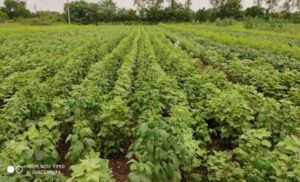 |
- Under rainfed based mechanized strip intercropping system, for obtaining higher productivity and monetary returns, it is recommended to adopt high density (45 x 15 cm) planting of deshi cotton (AKA-7) + soybean (6:6) with 40:50:25 NPK kg ha-1 or American cotton (AKH-081) + soybean (6:6) with 50:55:30 NPK kg ha-1 to both the crops and soybean strip sequenced with mustard at 45 x 15 cm spacing with recommended dose of fertilizer (40:20:20 NPK kg ha-1).
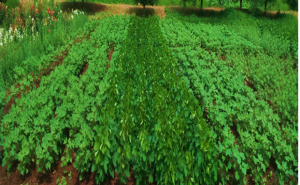 |
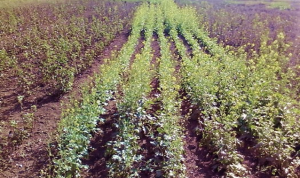 |
Rainwater Management
Efficient management of land and water resources on watershed basis not only minimizes the risk of soil erosion hazards and crops failure but also increases the productivity of land per unit area and time.
a. Evaluation of contour cultivation along vegetative hedges and graded bunds for soil and moisture conservation and productivity
For reducing runoff and soil erosion and increasing crop productivity, vegetative key lines of vetiver or leucaena may be developed on contours and sowing of crops and cultivation be done along the keylines.
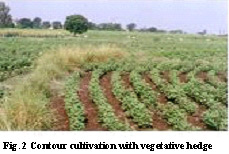
b. Topo-sequence study of micro-watershed for in-situ moisture conservation and sustainable crop production
For obtaining high monetary returns and soil and moisture conservation on slopy field (upto 3% slope), it is recommended to take soybean-chickpea double cropping on 30% area of lower topo-sequence in place of sole cotton under cotton based cropping system in dryland condition.
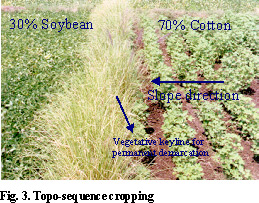
The yields of soybean and chickpea were higher under lower topo-sequence as compared to cotton. Monetary returns of different topo-sequence show higher values for soybean- chickpea double cropping as compared to cotton under lower topo-sequence. It is also observed that, the strip of soybean – chickpea reduced the runoff and soil loss to some extent.
c. Opening of furrows in cotton
For in situ soil moisture conservation and increased seed cotton yield it had been recommended to open furrows after every two rows of cotton at 30 to 35 days after sowing, furrows be opened by hoes.
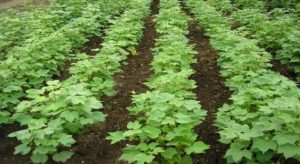
d. Interbund treatment of vetiver hedge
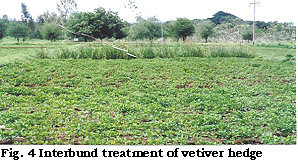
For reducing runoff and soil erosion and increasing crop productivity, vegetative key line of vetiver or Leucaena should be developed on contours and crops should be along the key lines.
e. Tillage and nutrient management for resource conservation and improving soil quality
In rainfed condition for sorghum crop, minimum tillage (one hoeing followed by one hand weeding) with 20kg nitrogen through inorganic fertilizer+20kg N through FYM (3.8t ha-1), 40kg P2O5 and 40kg K2O as basal dose and remaining 20kg nitrogen through inorganic fertilizer + 20kg through gliricidia (3t ha-1, at 30 DAS) is recommended for higher rainwater use efficiency, higher grain yield and enhanced soil fertility.
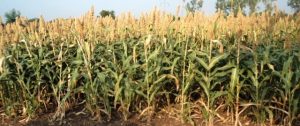
Crops and cropping systems
a. Identification of crops for shallow soils
On shallow soil, cotton variety AKH-081 recorded higher gross monetary returns as compared to other crops, viz., Pigeonpea (ICPL-85012), pearlmillet (ICTP-8203), seasamum (TC-25), horsegram (Local), blackgram (TAU-1) and sorghum (CSH-9). Hence, it is recommended for growing on shallow soil, under rainfed situations.
b. Sequence cropping system
Greengram-safflower crop sequence has been recommended for higher monetary returns. If rains occur in October, November month, sorghum- chickpea crop sequence is advocated. Soybean- chickpea crop sequence is also pheasible and giving higher monetary returns during late monsoon rains situation. Under situation of resowing or delayed sowing in kharif season, sunflower, pearl millet, pigeonpea, maize and castor crops recorded satisfactory yields.
c. Three tier intercropping
For obtaining higher monetary returns and meeting the need of food, fodder and fuel from one piece of land, it is recommended to adopt three tier cotton based intercropping system in which cotton, sorghum, pigeonpea and sorghum be grown in 6:1:2:1 row proportion under rainfed situation. This system has the highest capacity to bear risk of the season due to erratic behaviour of monsoon and also being adopted on reasonably sizeable area.
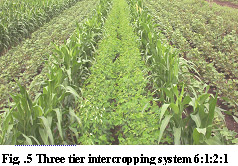
d. Upscaling of cotton+sorghum+pigeonpea+sorghum (6:1:2:1) intercropping systems in black soils of Western and Central Vidarbha region of Maharashtra
The improved practice cotton:sorghum:pigeonpea:sorghum (6:1:2:1) intercropping system gave significantly highest seed cotton equivalent yield of 963kg ha-1. The same system recorded highest gross and net monetary return of Rs. 39445ha-1 and Rs. 22571ha-1 respectively with B: C ratio of 2.37.
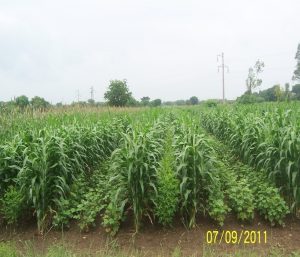
For ease in sowing Cotton:sorghum: pigeonpea: sorghum (3:1:1:1) recorded statistically at par NMR of Rs. 20032ha-1 with cotton:sorghum: pigeonpea:sorghum (6:1:2:1) and it also recorded B:C ratio of 2.28 with seed cotton equivalent yield of 871kg ha-1.
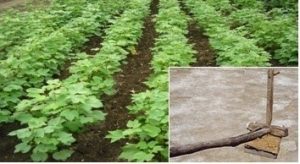
For obtaining higher cotton yield, monetary returns and improvement in soil fertility status integrated application of 50 % RDF (25:12.5:12.5 kg ha-1 N:P:K)+ FYM @5t ha-1 + PSB + Azotobactor and opening of furrow in each row at 30-40 DAS is recommended under dryland condition.
Nutrient management
The alley of green manuring crops like Leucaena at 9m interval in cotton or sorghum crops is recommended for incorporating its loppings for getting 25 to 50% economy in fertilizer use.
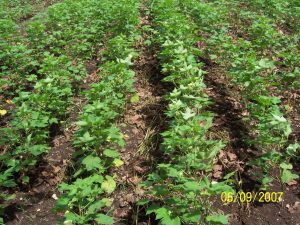
a. Integrated nutrient management studies in cotton+greengram intercropping
Application of 5t FYM + 25 kg P2O5 ha-1 as a basal dose and 25kg N ha-1 as top dressing after 30 days is recommended to cotton+greengram(1:1) intercropping system as an integrated plant nutrient supply system for sustainable fertility and productivity of soil in dryland agriculture.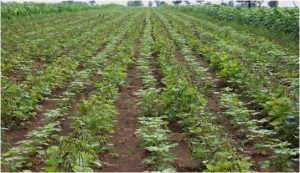
For obtaining higher yield and economic returns in zinc and boron deficient Vertisols, it is recommended to apply 25kg Zinc sulphate and 5kg Borax ha-1 alongwith 60:30:00 NPK kg ha-1 to rainfed American cotton.
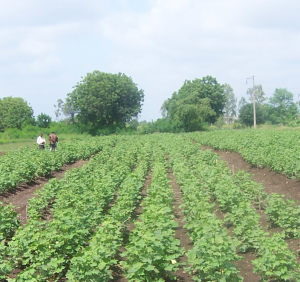
b. Integrated nutrient management in cotton under rainfed condition
For improvement in soil fertility, cotton productivity and obtaining higher monetary returns, application of 50% N (25kg ha-1) through glyricidia (3-4 t ha-1) +50% N through inorganics + biofertilizers (Azotobactor & PSB 25 g kg-1 seed treatment) + 25kg P2O5 + 25kg K2O ha-1 is recommended as an Integrated Plant Nutrient Supply System under dryland conditions of Vidarbha.
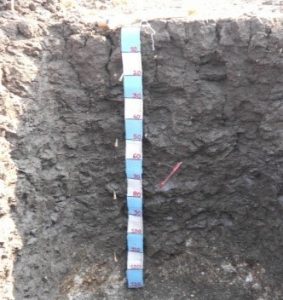
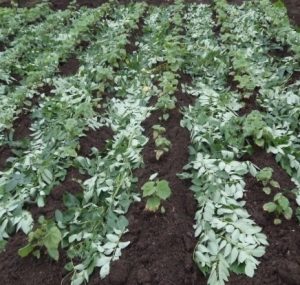
c. Integrated nutrient management in soybean under rainfed conditionFor improvement in soil fertility, soybean productivity and obtaining higher monetary returns, application of 50% recommended N (15kg ha-1) through glyricidia (2-3t ha-1)+50% N through inorganics+biofertilizers (Rhizobium & PSB 25g kg-1 seed treatment) + 75kg P2O5 + 25kg K2O ha-1 is recommended as an Integrated Plant Nutrient Supply System under dryland conditions of Vidarbha.

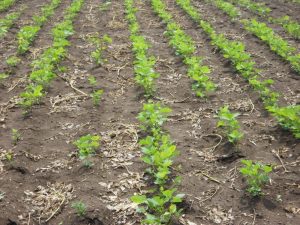
Crop Evaluation
Drought tolerance of cultivators
Screening and evaluation of some of the rainfed crops for drought tolerance and yield was taken up on the basis of the following physiological parameters and yield viz. Chlorophyll content, Chlorophyll stability index (CSI), Proline content of leaf, Osmotic potential of cell sap, Relative water content (RWC%), Transpiration rate, Stomatal conductance, Leaf area and Drought susceptibility index (DSI). On the basis this study the Soybean (Monetta and TAS-38), Sesamum (JLT-7 and TSE-4) and Sunflower (PKVSH-32 and MSFH –17) are found to be drought tolerant. Alternate land use systema. Agro-horticultural systems
Under dryland condition, ber ago-horticulture system (Ber + greengram/ blackgram) was found be more remunerative than anola and custard apple horticulture system.
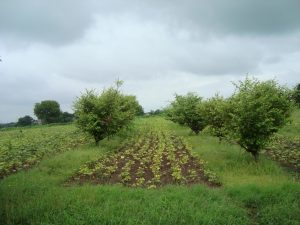
Growing stylo as a sole crop and stylo-marvel pastural system recorded higher green fodder yield than sole or combination of these two grasses.Efficient management of land and water resources, on watershed basis, not only minimizes the risk of soil erosion hazards and crops failure but also increases the productivity of land per unit area and time.
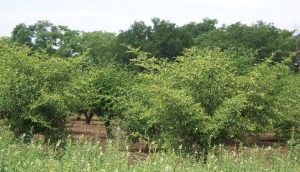
Contact Information
Dr.Anita B. Chorey
Chief Scientist
All India Co-ordinated Research Project for Dryland Agriculture
Dr. Panjabrao Deshmukh Krishi Vidyapeeth
Akola -444104 (Maharashtra)
